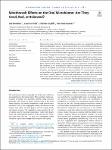Mouthwash Effects on the Oral Microbiome: Are They Good, Bad, or Balanced?
| dc.contributor.author | Brookes, Z | |
| dc.contributor.author | Teoh, L | |
| dc.contributor.author | Cieplik, F | |
| dc.contributor.author | Kumar, P | |
| dc.date.accessioned | 2023-11-27T17:46:34Z | |
| dc.date.available | 2023-11-27T17:46:34Z | |
| dc.date.issued | 2023-10 | |
| dc.identifier.issn | 0020-6539 | |
| dc.identifier.issn | 1875-595X | |
| dc.identifier.uri | https://pearl.plymouth.ac.uk/handle/10026.1/21709 | |
| dc.description.abstract |
This narrative review describes the oral microbiome, and its role in oral health and disease, before considering the impact of commonly used over-the-counter (OTC) mouthwashes on oral bacteria, viruses, bacteriophages, and fungi that make up these microbial communities in different niches of the mouth. Whilst certain mouthwashes have proven antimicrobial actions and clinical effectiveness supported by robust evidence, this review reports more recent metagenomics evidence, suggesting that mouthwashes such as chlorhexidine may cause “dysbiosis,” whereby certain species of bacteria are killed, leaving others, sometimes unwanted, to predominate. There is little known about the effects of mouthwashes on fungi and viruses in the context of the oral microbiome (virome) in vivo, despite evidence that they “kill” certain viral pathogens ex vivo. Evidence for mouthwashes, much like antibiotics, is also emerging with regards to antimicrobial resistance, and this should further be considered in the context of their widespread use by clinicians and patients. Therefore, considering the potential of currently available OTC mouthwashes to alter the oral microbiome, this article finally proposes that the ideal mouthwash, whilst combatting oral disease, should “balance” antimicrobial communities, especially those associated with health. Which antimicrobial mouthwash best fits this ideal remains uncertain. | |
| dc.format.extent | S74-S81 | |
| dc.format.medium | Print-Electronic | |
| dc.language | en | |
| dc.publisher | Elsevier BV | |
| dc.subject | Mouthwash | |
| dc.subject | Chlorhexidine | |
| dc.subject | Oral microbiome | |
| dc.subject | Bacteria | |
| dc.subject | Resistance | |
| dc.title | Mouthwash Effects on the Oral Microbiome: Are They Good, Bad, or Balanced? | |
| dc.type | journal-article | |
| dc.type | Article | |
| plymouth.author-url | https://www.ncbi.nlm.nih.gov/pubmed/37867065 | |
| plymouth.issue | Supplement 2 | |
| plymouth.volume | 73 | |
| plymouth.publication-status | Published | |
| plymouth.journal | International Dental Journal | |
| dc.identifier.doi | 10.1016/j.identj.2023.08.010 | |
| plymouth.organisational-group | |Plymouth | |
| plymouth.organisational-group | |Plymouth|Faculty of Health | |
| plymouth.organisational-group | |Plymouth|REF 2021 Researchers by UoA | |
| plymouth.organisational-group | |Plymouth|Users by role | |
| plymouth.organisational-group | |Plymouth|Users by role|Academics | |
| plymouth.organisational-group | |Plymouth|REF 2021 Researchers by UoA|UoA03 Allied Health Professions, Dentistry, Nursing and Pharmacy | |
| plymouth.organisational-group | |Plymouth|Faculty of Health|Peninsula Dental School | |
| plymouth.organisational-group | |Plymouth|REF 2028 Researchers by UoA | |
| plymouth.organisational-group | |Plymouth|REF 2028 Researchers by UoA|UoA03 Allied Health Professions, Dentistry, Nursing and Pharmacy | |
| dc.publisher.place | England | |
| dcterms.dateAccepted | 2023-08-21 | |
| dc.date.updated | 2023-11-27T17:46:34Z | |
| dc.rights.embargodate | 2023-11-28 | |
| dc.identifier.eissn | 1875-595X | |
| rioxxterms.versionofrecord | 10.1016/j.identj.2023.08.010 |


